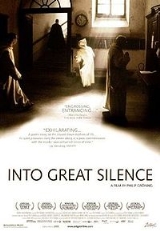
Into Great Silence
Encyclopedia
Into Great Silence is a documentary film
directed by Philip Gröning
that was first released in 2005. It is an intimate portrayal of the everyday lives of Carthusian
monks of the Grande Chartreuse
, high in the French Alps
(Chartreuse Mountains
). The idea for the film was proposed to the monks in 1984, but the Carthusians said they wanted time to think about it. The Carthusians finally contacted Gröning 16 years later to say they were now willing to permit Gröning to shoot the movie, if he was still interested. Gröning then came alone to live at the monastery, where no visitors were ordinarily allowed, for four and a half months starting in mid-March 2002. He filmed and recorded the sound on his own, using no artificial light. Additional shooting of the documentary took place in December and January; Gröning spent a total of six months filming in the monastery and took about two and a half years to edit the film before its release. The film has neither commentary nor sound effects added, consisting only of images and sounds of the rhythm of monastic life.
and a "certified fresh" rating. United States Conference of Catholic Bishops' Office for Film and Broadcasting
listed Into Great Silence as one of the best ten films of 2007. The Carthusian monks themselves loved the film.
Documentary film
Documentary films constitute a broad category of nonfictional motion pictures intended to document some aspect of reality, primarily for the purposes of instruction or maintaining a historical record...
directed by Philip Gröning
Philip Gröning
Philip Gröning is a German director, documentary film maker, and screenwriter.- Career :He was raised in Germany and US, but also traveled extensively. He studied Medicine and Psychology before beginning in the cinema with some acting. In 1986 he began doing his own films...
that was first released in 2005. It is an intimate portrayal of the everyday lives of Carthusian
Carthusian
The Carthusian Order, also called the Order of St. Bruno, is a Roman Catholic religious order of enclosed monastics. The order was founded by Saint Bruno of Cologne in 1084 and includes both monks and nuns...
monks of the Grande Chartreuse
Grande Chartreuse
Grande Chartreuse is the head monastery of the Carthusian order. It is located in the Chartreuse Mountains, north of the city of Grenoble, in the commune of Saint-Pierre-de-Chartreuse , France. Originally, the château belonged to the See of Grenoble...
, high in the French Alps
French Alps
The French Alps are those portions of the Alps mountain range which stand within France, located in the Rhône-Alpes and Provence-Alpes-Côte d'Azur regions....
(Chartreuse Mountains
Chartreuse Mountains
The Chartreuse Mountains is a mountain range in eastern France, stretching to the north from the city of Grenoble to the Lac du Bourget. It is the southernmost range in the Jura Mountains and belongs to the French Prealps....
). The idea for the film was proposed to the monks in 1984, but the Carthusians said they wanted time to think about it. The Carthusians finally contacted Gröning 16 years later to say they were now willing to permit Gröning to shoot the movie, if he was still interested. Gröning then came alone to live at the monastery, where no visitors were ordinarily allowed, for four and a half months starting in mid-March 2002. He filmed and recorded the sound on his own, using no artificial light. Additional shooting of the documentary took place in December and January; Gröning spent a total of six months filming in the monastery and took about two and a half years to edit the film before its release. The film has neither commentary nor sound effects added, consisting only of images and sounds of the rhythm of monastic life.
Reception
The film has experienced generally laudatory reception, with 89% critics responding with positive reviews at T-metric section of Rotten TomatoesRotten Tomatoes
Rotten Tomatoes is a website devoted to reviews, information, and news of films—widely known as a film review aggregator. Its name derives from the cliché of audiences throwing tomatoes and other vegetables at a poor stage performance...
and a "certified fresh" rating. United States Conference of Catholic Bishops' Office for Film and Broadcasting
United States Conference of Catholic Bishops' Office for Film and Broadcasting
United States Conference of Catholic Bishops' Office for Film and Broadcasting is an office of the United States Conference of Catholic Bishops and is best known for the USCCB film rating, a continuation of the National Legion of Decency rating system begun in 1933 by Archbishop of Cincinnati John T...
listed Into Great Silence as one of the best ten films of 2007. The Carthusian monks themselves loved the film.
Awards
- Special Jury Prize at the 2006 Sundance Festival.
- European Film Awards 2006, Documentary - Prix Arte
See also
- HermitHermitA hermit is a person who lives, to some degree, in seclusion from society.In Christianity, the term was originally applied to a Christian who lives the eremitic life out of a religious conviction, namely the Desert Theology of the Old Testament .In the...
- MonasticismMonasticismMonasticism is a religious way of life characterized by the practice of renouncing worldly pursuits to fully devote one's self to spiritual work...
- St. BrunoBruno of CologneSaint Bruno of Cologne , the founder of the Carthusian Order, personally founded the order's first two communities...
, the founder of the Carthusian Order - Cistercians (another monastic order which practices silence)
- Desert FathersDesert FathersThe Desert Fathers were hermits, ascetics, monks, and nuns who lived mainly in the Scetes desert of Egypt beginning around the third century AD. The most well known was Anthony the Great, who moved to the desert in 270–271 and became known as both the father and founder of desert monasticism...

